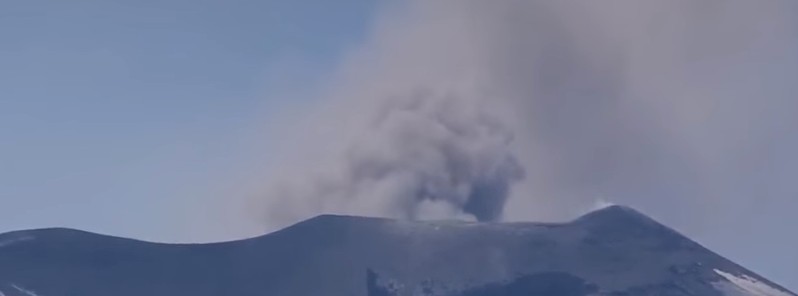Ash emissions from Etna’s Northeast Crater, Italy

Intermittent weak to moderate ash emissions are being observed at Northeast Crater of Italy's Mount Etna over the last couple of days.
Weak incandescence can be observed at night, but current events show no signs that could indicate fresh lava. Surface temperatures and seismic activity are low, Volcano Discovery reports.
After December 2 and 3, 2015, when the volcano erupted in the most violent paroxysm in two decades, activity at Mount Etna has calmed down.
The following videos were captured by Turi Caggegi on April 3 and March 31, 2016:

Video courtesy Turi Caggegi


Video courtesy Turi Caggegi
Geological summary
Mount Etna, towering above Catania, Sicily's second largest city, has one of the world's longest documented records of historical volcanism, dating back to 1500 BCE. Historical lava flows of basaltic composition cover much of the surface of this massive volcano, whose edifice is the highest and most voluminous in Italy. The Mongibello stratovolcano, truncated by several small calderas, was constructed during the late Pleistocene and Holocene over an older shield volcano. The most prominent morphological feature of Etna is the Valle del Bove, a 5 x 10 km (16 404 x 32 808 feet)horseshoe-shaped caldera open to the east.
Two styles of eruptive activity typically occur at Etna. Persistent explosive eruptions, sometimes with minor lava emissions, take place from one or more of the three prominent summit craters, the Central Crater, NE Crater, and SE Crater (the latter formed in 1978). Flank vents, typically with higher effusion rates, are less frequently active and originate from fissures that open progressively downward from near the summit (usually accompanied by strombolian eruptions at the upper end). Cinder cones are commonly constructed over the vents of lower-flank lava flows. Lava flows extend to the foot of the volcano on all sides and have reached the sea over a broad area on the SE flank. (GVP)
Featured image credit: Turi Caggegi

Commenting rules and guidelines
We value the thoughts and opinions of our readers and welcome healthy discussions on our website. In order to maintain a respectful and positive community, we ask that all commenters follow these rules.